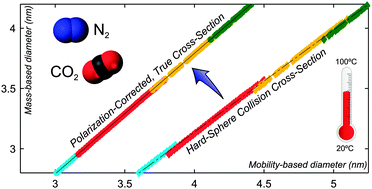Electrical mobilities of multiply charged ionic-liquid nanodrops in air and carbon dioxide over a wide temperature range: influence of ion-induced dipole interactions†
Abstract
The electrical mobilities of hundreds of mass-selected, multiply charged nanodrops (2–6 nm in diameter) of the ionic liquid EMI-BF4 have been measured in air and CO2 at temperatures, T, ranging from 20 to 100 °C, extending previous studies, based on EMI-N(CN)2 nanodrops in air at 20 °C, to other temperatures and drift gases. The known compressibility of EMI-BF4 removes prior slight ambiguities in the mass-based determination of nanodrop diameters. We confirm the previous finding that the collision cross-sections Ω of these nanodrops, inferred from their electrical mobilities, are related to their diameters d via a relation of the form  , where ε* is the ratio between the polarization and thermal energies of the ion–gas molecule system at contact, f(Kn) is a continuum-correction that vanishes in the free-molecule limit, and the coefficients dg, β, and ξ are inferred experimentally as functions of temperature and drift gas. This expression for Ω(d,z) enables determining true (geometric) cross-sections of globular ions from their measured electrical mobilities in molecular gases. We also corroborate prior reports that the drag-enhancement factor ξ, which remains nearly constant with temperature and drift-gas, exceeds slightly the value ξm ≈ 1.36 established by Millikan's oil drop measurements. Unexpectedly, the coefficient β shows a significant temperature dependence, suggesting that the ion–gas molecule scattering process is affected by T. The effective gas-molecule collision diameter dg is seen to decrease with T, and takes a value in excess of 0.45 nm in CO2 at 20 °C, considerably larger than in room-temperature air.
, where ε* is the ratio between the polarization and thermal energies of the ion–gas molecule system at contact, f(Kn) is a continuum-correction that vanishes in the free-molecule limit, and the coefficients dg, β, and ξ are inferred experimentally as functions of temperature and drift gas. This expression for Ω(d,z) enables determining true (geometric) cross-sections of globular ions from their measured electrical mobilities in molecular gases. We also corroborate prior reports that the drag-enhancement factor ξ, which remains nearly constant with temperature and drift-gas, exceeds slightly the value ξm ≈ 1.36 established by Millikan's oil drop measurements. Unexpectedly, the coefficient β shows a significant temperature dependence, suggesting that the ion–gas molecule scattering process is affected by T. The effective gas-molecule collision diameter dg is seen to decrease with T, and takes a value in excess of 0.45 nm in CO2 at 20 °C, considerably larger than in room-temperature air.


 Please wait while we load your content...
Please wait while we load your content...